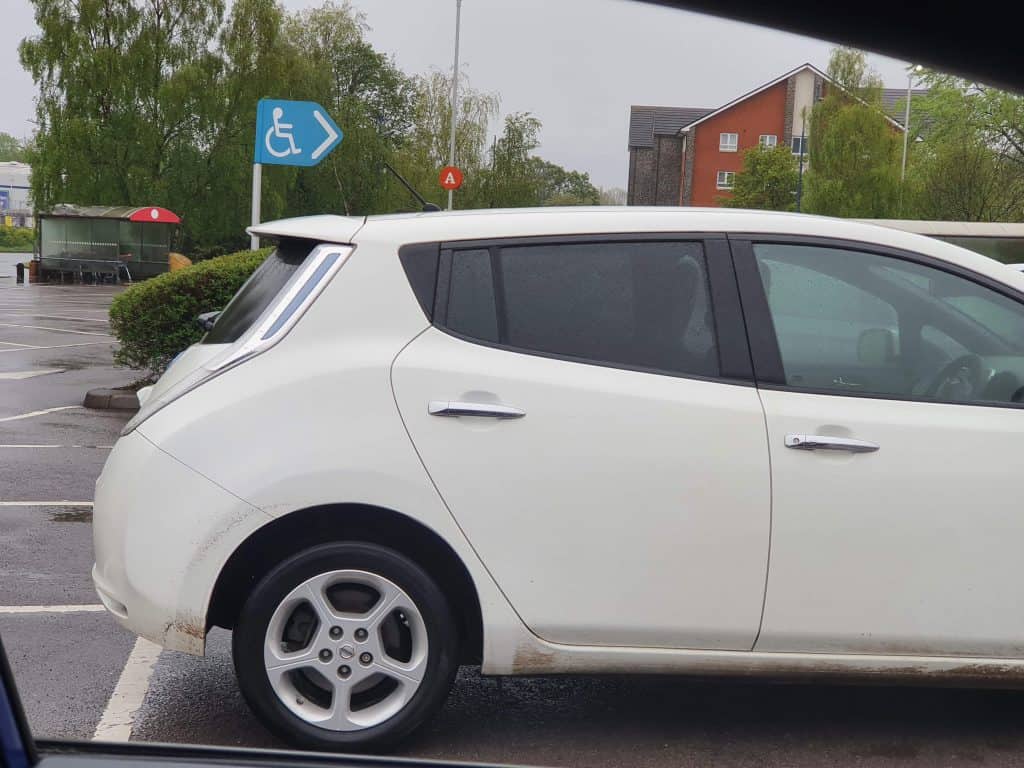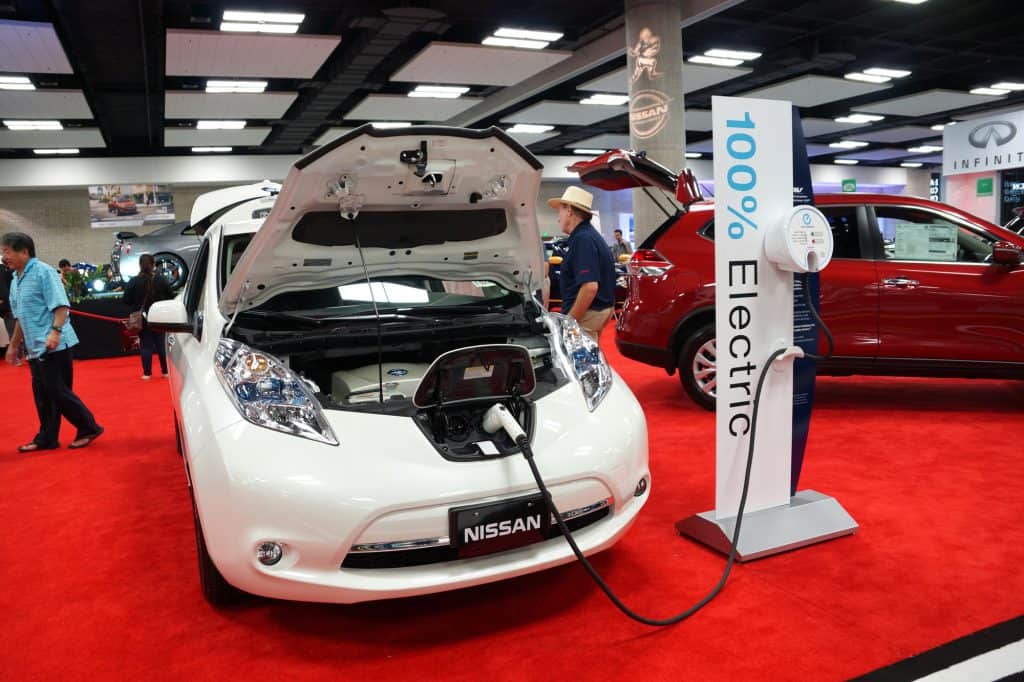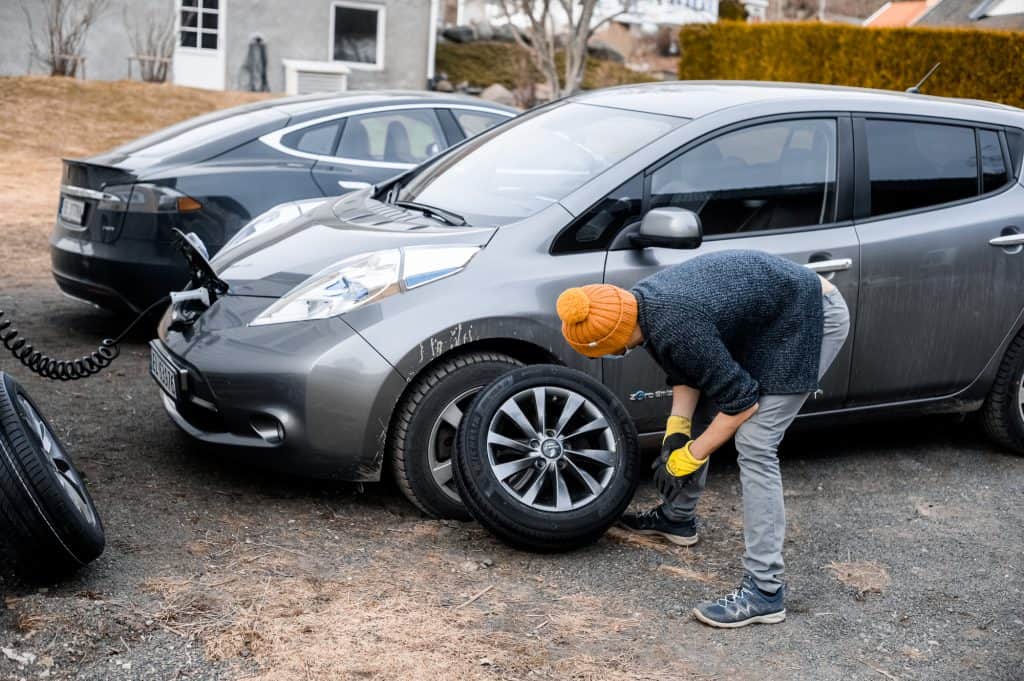Having a spare tire located somewhere within your car — often in a spare tire recess within the car’s trunk — is a kind of safety net against the nightmare scenario of a blowout resulting in the need for you to change a tire. The issue of spare tires has long plagued the discussions and views of electric vehicles, whose battery packs prohibit the ability of manufacturers to easily put a spare tire in that same space.
Even the Nissan Leaf, with its class-beating 23.6 cubic feet of cargo space, would have an issue storing a spare tire, which on average might take up 4.5 cubic feet of space. It certainly would take away a good chunk of that trunk space that you want for your everyday gear, groceries, kids’ school stuff and more.
Nissan has not ignored the potential need for tire repair and instant maintenance, however. They have included a tire repair kit as a standard item within the Nissan Leaf when purchased. The idea is that the kit will help you stay on the damaged tire just long enough and safely enough to reach the nearest service center or other repair shop where you can have the tire replaced.
Why No Spare Tire?

As we touched on above, the Nissan Leaf, as with virtually all electric and green cars with floor-mounted battery packs, has no spare tire. Environmentally friendly cars are actually not unique in this respect at all. According to whatcar.com, most cars nowadays are sacrificing the spare tire and offering tire repair kits instead, but why? Well, there’s a variety of good reasons:
1. Fuel Efficiency
A tire can weigh as much as 50 pounds, and any additional weight on the car will have an impact on its overall efficiency. This one applies to both gasoline and electric vehicles in their own way, but is actually very important for the cars like the Nissan Leaf because the typical EV is already very heavily laden with its monster battery pack.
The second-generation Nissan Leaf weighs up to 3,620lbs (1,640kg). Its battery is made up of 24 modules, each module weighing 8.7kg (just over 19lbs), which creates a total of 458lbs or thereabouts. That’s just the battery! Adding 50 pounds with a spare tire just doesn’t make sense.
2. Giving More Space to Smaller Vehicles
The Nissan Leaf is quite generous with interior cargo space, as we mentioned above, but many other smaller cars are more limited. EVs often have what has become called a “Frunk” since there is no longer a hulking great engine lurking beneath the car’s hood any more. This gives way to a “Front Trunk,” or “Frunk.” That’s extra space for EVs, but still most small cars include a big premium on space and therefore manufacturers don’t want to waste it with spare tires.
3. Batteries in EVs

Another key factor in fewer manufacturers offering spare tires is that EVs have their main battery pack mounted on the lower portion of the car, which together occupies a space that might have once included the recess under the trunk for the spare tire. No such space any more. The bigger the battery, the less space there is.
4. Lowering Production Costs
Offering a spare tire and creating a space in which to store it makes cars more expensive to produce. Therefore, offering vehicles without spare tires can lower costs — sometimes by several hundred dollars — savings from which can be passed on directly to the consumer.
5. Better Tires
The advent of “run-flat tires” has changed the way we think about spare tires, too. These are tires that will allow you to drive on them even when punctured thanks to a reinforced sidewall and/or an interior support ring that can support the vehicle’s weight at least until you find your way to a service center. These run-flat tires can last anywhere from 10 to 50 miles depending on the specific brand and type, which is at the very least giving drivers the ability to find a safe spot to pull over and summon help, or in most cases safely drive on to an auto garage or tire repair center.
With such tires now essentially the norm, even consumers don’t feel any pangs of nostalgia or pain in missing their precious spare tires. Times have changed and so have the vehicles. We all have to move with the times.
Is it Worth Buying a Spare Tire for Nissan Leaf?

This is a good question, and like many things in the driving world it will depend largely on your particular environment and circumstances. If you live in a fairly temperate zone without any weather or temperature extremes, and you spend all your time either on your driveway or traversing the mostly even and well-paved public roads of your neighborhood, then you could argue that there is little recourse to purchase a spare tire for your Nissan Leaf.
On the other hand, if you drive longer distances, or across roads or surfaces where the ground is somewhat more uneven, or if you ever feel your regular driving routes or habits present a risk of being stranded, then you might consider the idea. The question, however, is where you would put it. There is no OEM accessory or kit to mount the tire somewhere in your car, but there have been some aftermarket solutions.
Nissan Leaf Tire Repair Kit – Another Reason You Don’t Need a Spare Tire
Some people still consider getting a spare tire because they don’t realize how simple to use and how handy the official Nissan Leaf tire repair kit provided by Continental is. It’s an entirely self-contained repair kit that requires no special knowledge or skill to use, with very clear instructions so that even first-time users can get it right.
The kit is located in the trunk of your Nissan Leaf. It’s either under the carpet or in a concealed compartment to the left of the trunk, depending on your exact model. The kit is contained in a fairly small plastic container, with text and image step-by-step instructions on how to operate it. The kit’s two main items are a bottle of tire sealant and an air compressor. It is powered by plugging the car into the standard power socket in your Leaf.
When used correctly, the kit then allows you to drive on to find help from a Nissan Service Center. There are even adjusted speed limit and driving guidelines printed onto a sticker with the kit. You can take this off the repair kit and stick it to your steering wheel to remind you how to drive safely on a repaired wheel. After a short distance — 6 miles or so — you check on the tire to see the pressure. If it’s holding, at more than 31psi, then you can continue. If it’s lower than 19psi, then you stop and call for assistance.
In short, the tire repair kit is a neat and elegant temporary solution that greatly negates the need for a spare tire in your Nissan Leaf.
Conclusion: Nissan Leaf Spare Tire, Only If You Want
When reviewing the options available for Leaf drivers today, it is clear that a spare tire is not a necessity any more. The manufacturers aren’t just responding to a need to save money and space in cars, but also to consumer demand. When it’s apparent that no one is using the item that you take such pains to have installed in the vehicle, then why bother continuing?
Those who want to get a spare tire on their Leaf can find solutions to that. Aftermarket tire cradles have been available since at least 2012, often mounted under the car so as not to take up any of your trunk or cargo space. In the end, then, a Nissan Leaf spare tire is only a good purchase if you really think you need or want one.
12 comments
So you dont need a spare tire, until you need one. I just had a blowout, too much for the wee repair kit to handle. Its a $200 tow to the nearest dealer. A spare would be pretty handy.
Hmm, that’s a fair point Ron! 🙂
– A Donut with scissor jack and fold up wheel nut wrench in the trunk is a good option. Take it out on the rare occasion you need the trunk space.
– Check your tire pressure and/or look at your tires regularly.
– Don’t let your tread go down too far (40%). Flat tires, blow-outs, etc. mostly happen to worn down tires (but not always).
I just bought my 2021 Leaf last week. And tonight, in a snowstorm, I hit a pothole and had an immediately flat front passenger tire. I am now looking into a spare tire option as this is the only the second time in almost 30 years of driving that I’ve had to call for a tow for a tire that I couldn’t change. The last time was due to a spilled box of nails in the road and 3 flats at once. I understand some of the arguments for leaving the spare off, but I just don’t think it makes practical sense. I don’t like being stranded.
Sorry to hear it Regina. I’ve had similar – ending up in the middle of nowhere with a flat, and it’s rubbish. I really think that spare tires are essential, not just a “nice to have”.
If they can fail a warrant for a spare tire in any other car, all Nissan Leaf cars should fail also for not having one.
After just purchasing one and not knowing their was No spare not sure I will be taking this car far from the town I live in here in NZ.
Sadly the Nissan dealer I purchased this from needs some education as I am having to find these things out day by day for this car it’s faults etc
A fair point Sam, and sorry to hear about your local Nissan dealer.
After a flat with my Leaf, I used the tire repair kit. I then learned, when buying a new tire, that the goop that the repair kit fills the tire with destroys the pressure sensor. A new one of those, after market, was a hundred bucks. I wish I had waited for AAA instead to tow my car to the tire shop.
TIL. That sucks, sorry to hear it. I hadn’t thought of that, but it would make sense (albeit, it’s really annoying). Yes, getting a tow is usually worth it – but sometimes they haven’t got a tow truck available, meaning you might have to wait a LOT longer.
The notion that Nissan’s ‘tire repair’ kit makes a spare tire unnecessary is complete nonsense. I used mine and thankfully it did work. When I went to Nissan to replace the 6oz bottle of goo that gets pumped into the tire they said it was over $100. Why should Nissan need to gouge their customers in such a blatant shameful way?
I had a flat with my 2017 Leaf and discovered the ‘solution’ Nissan has come up with. The compressor and goo did work but when I went to Nissan to replace the goo I discovered that Nissan wants something like $125 for the small can of goo which I find rather insulting.
This is my 4th Leaf, so I’m a big fan. However I’ve had at LEAST 6 flat tires that have cost me so much more time and money than necessary. I can change a tire in 15 min, and be on my way. I’d like a Nissan exec to be with me the next time I blow a hole in the sidewall of the (crap) tires that come with the S model, on a Friday night of a holiday weekend in a small town. This can (and has) cost me hundred of dollars in unnecessary expenses (easily killing any fuel cost savings I might have had by driving an ev). I really like the leaf, but every time I think about the tire situation, it makes my blood boil.